Input interpretation

NaOH (sodium hydroxide) + Br_2 (bromine) ⟶ H_2O (water) + NaBr (sodium bromide) + NaBrO_3 (sodium bromate)
Balanced equation
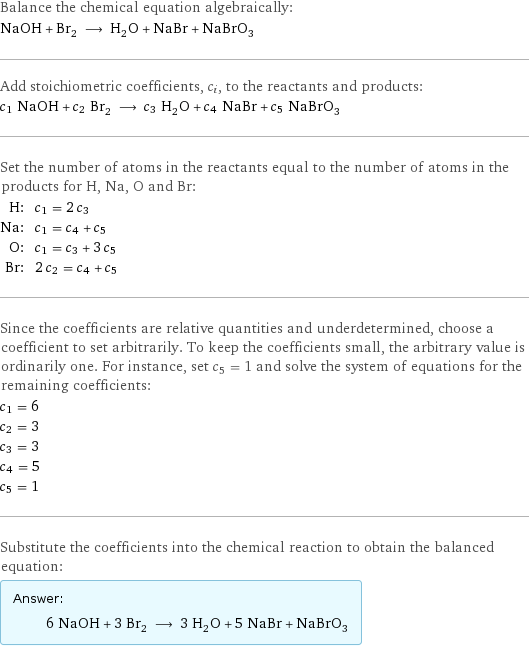
Balance the chemical equation algebraically: NaOH + Br_2 ⟶ H_2O + NaBr + NaBrO_3 Add stoichiometric coefficients, c_i, to the reactants and products: c_1 NaOH + c_2 Br_2 ⟶ c_3 H_2O + c_4 NaBr + c_5 NaBrO_3 Set the number of atoms in the reactants equal to the number of atoms in the products for H, Na, O and Br: H: | c_1 = 2 c_3 Na: | c_1 = c_4 + c_5 O: | c_1 = c_3 + 3 c_5 Br: | 2 c_2 = c_4 + c_5 Since the coefficients are relative quantities and underdetermined, choose a coefficient to set arbitrarily. To keep the coefficients small, the arbitrary value is ordinarily one. For instance, set c_5 = 1 and solve the system of equations for the remaining coefficients: c_1 = 6 c_2 = 3 c_3 = 3 c_4 = 5 c_5 = 1 Substitute the coefficients into the chemical reaction to obtain the balanced equation: Answer: | | 6 NaOH + 3 Br_2 ⟶ 3 H_2O + 5 NaBr + NaBrO_3
Structures

+ ⟶ + +
Names

sodium hydroxide + bromine ⟶ water + sodium bromide + sodium bromate
Reaction thermodynamics
Enthalpy
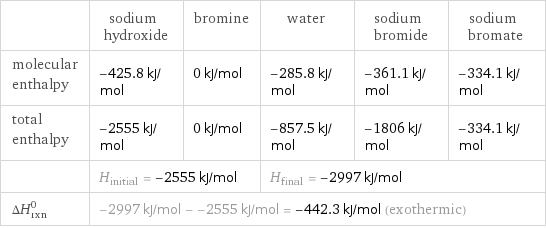
| sodium hydroxide | bromine | water | sodium bromide | sodium bromate molecular enthalpy | -425.8 kJ/mol | 0 kJ/mol | -285.8 kJ/mol | -361.1 kJ/mol | -334.1 kJ/mol total enthalpy | -2555 kJ/mol | 0 kJ/mol | -857.5 kJ/mol | -1806 kJ/mol | -334.1 kJ/mol | H_initial = -2555 kJ/mol | | H_final = -2997 kJ/mol | | ΔH_rxn^0 | -2997 kJ/mol - -2555 kJ/mol = -442.3 kJ/mol (exothermic) | | | |
Gibbs free energy
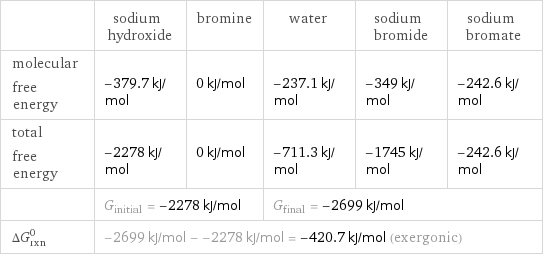
| sodium hydroxide | bromine | water | sodium bromide | sodium bromate molecular free energy | -379.7 kJ/mol | 0 kJ/mol | -237.1 kJ/mol | -349 kJ/mol | -242.6 kJ/mol total free energy | -2278 kJ/mol | 0 kJ/mol | -711.3 kJ/mol | -1745 kJ/mol | -242.6 kJ/mol | G_initial = -2278 kJ/mol | | G_final = -2699 kJ/mol | | ΔG_rxn^0 | -2699 kJ/mol - -2278 kJ/mol = -420.7 kJ/mol (exergonic) | | | |
Equilibrium constant
![Construct the equilibrium constant, K, expression for: NaOH + Br_2 ⟶ H_2O + NaBr + NaBrO_3 Plan: • Balance the chemical equation. • Determine the stoichiometric numbers. • Assemble the activity expression for each chemical species. • Use the activity expressions to build the equilibrium constant expression. Write the balanced chemical equation: 6 NaOH + 3 Br_2 ⟶ 3 H_2O + 5 NaBr + NaBrO_3 Assign stoichiometric numbers, ν_i, using the stoichiometric coefficients, c_i, from the balanced chemical equation in the following manner: ν_i = -c_i for reactants and ν_i = c_i for products: chemical species | c_i | ν_i NaOH | 6 | -6 Br_2 | 3 | -3 H_2O | 3 | 3 NaBr | 5 | 5 NaBrO_3 | 1 | 1 Assemble the activity expressions accounting for the state of matter and ν_i: chemical species | c_i | ν_i | activity expression NaOH | 6 | -6 | ([NaOH])^(-6) Br_2 | 3 | -3 | ([Br2])^(-3) H_2O | 3 | 3 | ([H2O])^3 NaBr | 5 | 5 | ([NaBr])^5 NaBrO_3 | 1 | 1 | [NaBrO3] The equilibrium constant symbol in the concentration basis is: K_c Mulitply the activity expressions to arrive at the K_c expression: Answer: | | K_c = ([NaOH])^(-6) ([Br2])^(-3) ([H2O])^3 ([NaBr])^5 [NaBrO3] = (([H2O])^3 ([NaBr])^5 [NaBrO3])/(([NaOH])^6 ([Br2])^3)](../image_source/cebed5c0361c4e9f74041b108d6c2c0b.png)
Construct the equilibrium constant, K, expression for: NaOH + Br_2 ⟶ H_2O + NaBr + NaBrO_3 Plan: • Balance the chemical equation. • Determine the stoichiometric numbers. • Assemble the activity expression for each chemical species. • Use the activity expressions to build the equilibrium constant expression. Write the balanced chemical equation: 6 NaOH + 3 Br_2 ⟶ 3 H_2O + 5 NaBr + NaBrO_3 Assign stoichiometric numbers, ν_i, using the stoichiometric coefficients, c_i, from the balanced chemical equation in the following manner: ν_i = -c_i for reactants and ν_i = c_i for products: chemical species | c_i | ν_i NaOH | 6 | -6 Br_2 | 3 | -3 H_2O | 3 | 3 NaBr | 5 | 5 NaBrO_3 | 1 | 1 Assemble the activity expressions accounting for the state of matter and ν_i: chemical species | c_i | ν_i | activity expression NaOH | 6 | -6 | ([NaOH])^(-6) Br_2 | 3 | -3 | ([Br2])^(-3) H_2O | 3 | 3 | ([H2O])^3 NaBr | 5 | 5 | ([NaBr])^5 NaBrO_3 | 1 | 1 | [NaBrO3] The equilibrium constant symbol in the concentration basis is: K_c Mulitply the activity expressions to arrive at the K_c expression: Answer: | | K_c = ([NaOH])^(-6) ([Br2])^(-3) ([H2O])^3 ([NaBr])^5 [NaBrO3] = (([H2O])^3 ([NaBr])^5 [NaBrO3])/(([NaOH])^6 ([Br2])^3)
Rate of reaction
![Construct the rate of reaction expression for: NaOH + Br_2 ⟶ H_2O + NaBr + NaBrO_3 Plan: • Balance the chemical equation. • Determine the stoichiometric numbers. • Assemble the rate term for each chemical species. • Write the rate of reaction expression. Write the balanced chemical equation: 6 NaOH + 3 Br_2 ⟶ 3 H_2O + 5 NaBr + NaBrO_3 Assign stoichiometric numbers, ν_i, using the stoichiometric coefficients, c_i, from the balanced chemical equation in the following manner: ν_i = -c_i for reactants and ν_i = c_i for products: chemical species | c_i | ν_i NaOH | 6 | -6 Br_2 | 3 | -3 H_2O | 3 | 3 NaBr | 5 | 5 NaBrO_3 | 1 | 1 The rate term for each chemical species, B_i, is 1/ν_i(Δ[B_i])/(Δt) where [B_i] is the amount concentration and t is time: chemical species | c_i | ν_i | rate term NaOH | 6 | -6 | -1/6 (Δ[NaOH])/(Δt) Br_2 | 3 | -3 | -1/3 (Δ[Br2])/(Δt) H_2O | 3 | 3 | 1/3 (Δ[H2O])/(Δt) NaBr | 5 | 5 | 1/5 (Δ[NaBr])/(Δt) NaBrO_3 | 1 | 1 | (Δ[NaBrO3])/(Δt) (for infinitesimal rate of change, replace Δ with d) Set the rate terms equal to each other to arrive at the rate expression: Answer: | | rate = -1/6 (Δ[NaOH])/(Δt) = -1/3 (Δ[Br2])/(Δt) = 1/3 (Δ[H2O])/(Δt) = 1/5 (Δ[NaBr])/(Δt) = (Δ[NaBrO3])/(Δt) (assuming constant volume and no accumulation of intermediates or side products)](../image_source/9424b49104d86d3067bbbfe92bc7ad60.png)
Construct the rate of reaction expression for: NaOH + Br_2 ⟶ H_2O + NaBr + NaBrO_3 Plan: • Balance the chemical equation. • Determine the stoichiometric numbers. • Assemble the rate term for each chemical species. • Write the rate of reaction expression. Write the balanced chemical equation: 6 NaOH + 3 Br_2 ⟶ 3 H_2O + 5 NaBr + NaBrO_3 Assign stoichiometric numbers, ν_i, using the stoichiometric coefficients, c_i, from the balanced chemical equation in the following manner: ν_i = -c_i for reactants and ν_i = c_i for products: chemical species | c_i | ν_i NaOH | 6 | -6 Br_2 | 3 | -3 H_2O | 3 | 3 NaBr | 5 | 5 NaBrO_3 | 1 | 1 The rate term for each chemical species, B_i, is 1/ν_i(Δ[B_i])/(Δt) where [B_i] is the amount concentration and t is time: chemical species | c_i | ν_i | rate term NaOH | 6 | -6 | -1/6 (Δ[NaOH])/(Δt) Br_2 | 3 | -3 | -1/3 (Δ[Br2])/(Δt) H_2O | 3 | 3 | 1/3 (Δ[H2O])/(Δt) NaBr | 5 | 5 | 1/5 (Δ[NaBr])/(Δt) NaBrO_3 | 1 | 1 | (Δ[NaBrO3])/(Δt) (for infinitesimal rate of change, replace Δ with d) Set the rate terms equal to each other to arrive at the rate expression: Answer: | | rate = -1/6 (Δ[NaOH])/(Δt) = -1/3 (Δ[Br2])/(Δt) = 1/3 (Δ[H2O])/(Δt) = 1/5 (Δ[NaBr])/(Δt) = (Δ[NaBrO3])/(Δt) (assuming constant volume and no accumulation of intermediates or side products)
Chemical names and formulas
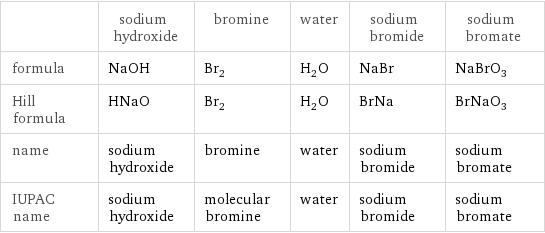
| sodium hydroxide | bromine | water | sodium bromide | sodium bromate formula | NaOH | Br_2 | H_2O | NaBr | NaBrO_3 Hill formula | HNaO | Br_2 | H_2O | BrNa | BrNaO_3 name | sodium hydroxide | bromine | water | sodium bromide | sodium bromate IUPAC name | sodium hydroxide | molecular bromine | water | sodium bromide | sodium bromate
Substance properties
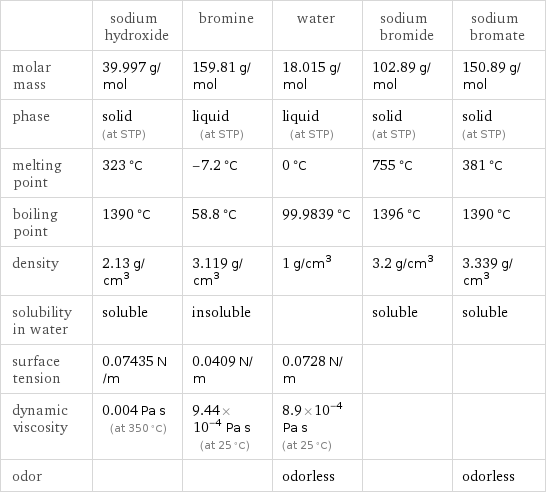
| sodium hydroxide | bromine | water | sodium bromide | sodium bromate molar mass | 39.997 g/mol | 159.81 g/mol | 18.015 g/mol | 102.89 g/mol | 150.89 g/mol phase | solid (at STP) | liquid (at STP) | liquid (at STP) | solid (at STP) | solid (at STP) melting point | 323 °C | -7.2 °C | 0 °C | 755 °C | 381 °C boiling point | 1390 °C | 58.8 °C | 99.9839 °C | 1396 °C | 1390 °C density | 2.13 g/cm^3 | 3.119 g/cm^3 | 1 g/cm^3 | 3.2 g/cm^3 | 3.339 g/cm^3 solubility in water | soluble | insoluble | | soluble | soluble surface tension | 0.07435 N/m | 0.0409 N/m | 0.0728 N/m | | dynamic viscosity | 0.004 Pa s (at 350 °C) | 9.44×10^-4 Pa s (at 25 °C) | 8.9×10^-4 Pa s (at 25 °C) | | odor | | | odorless | | odorless
Units
